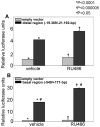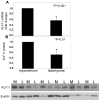Transcription factor KLF11 integrates progesterone receptor signaling and proliferation in uterine leiomyoma cells
- PMID: 20124487
- PMCID: PMC2822899
- DOI: 10.1158/0008-5472.CAN-09-2612
Transcription factor KLF11 integrates progesterone receptor signaling and proliferation in uterine leiomyoma cells
Abstract
Uterine leiomyoma is the most common tumor of the female genital tract and the leading cause of hysterectomy. Although progesterone stimulates the proliferation of uterine leiomyoma cells, the mechanism of progesterone action is not well understood. We used chromatin immunoprecipitation (ChIP)-cloning approach to identify progesterone receptor (PR) target genes in primary uterine leiomyoma smooth muscle cells. We identified 18 novel PR-binding sites, one of which was located 20.5 kb upstream of the transcriptional start site of the Krüppel-like transcription factor 11 (KLF11) gene. KLF11 mRNA levels were minimally downregulated by progesterone but robustly upregulated by the progesterone antagonist RU486. Luciferase reporter assays showed significant baseline and RU486-inducible promoter activity in the KLF11 basal promoter or distal PR-binding region, both of which contained multiple Sp1-binding sequences but lacked classic progesterone response elements. RU486 stimulated recruitment of Sp1, RNA polymerase II, PR, and the coactivators SRC-1 and SRC-2 to the distal region and basal promoter. siRNA knockdown of PR increased KLF11 expression, whereas knockdown of KLF11 increased leiomyoma cell proliferation and abolished the antiproliferative effect of RU486. In vivo, KLF11 expression was significantly lower in leiomyoma tissues compared with adjacent myometrial tissues. Taken together, using a ChIP-cloning approach, we uncovered KLF11 as an integrator of PR signaling and proliferation in uterine leiomyoma cells.
Figures






Similar articles
-
Genome-wide progesterone receptor binding: cell type-specific and shared mechanisms in T47D breast cancer cells and primary leiomyoma cells.PLoS One. 2012;7(1):e29021. doi: 10.1371/journal.pone.0029021. Epub 2012 Jan 17. PLoS One. 2012. PMID: 22272226 Free PMC article.
-
Progesterone and mifepristone regulate L-type amino acid transporter 2 and 4F2 heavy chain expression in uterine leiomyoma cells.J Clin Endocrinol Metab. 2009 Nov;94(11):4533-9. doi: 10.1210/jc.2009-1286. Epub 2009 Oct 6. J Clin Endocrinol Metab. 2009. PMID: 19808856 Free PMC article.
-
Ovarian steroid hormones modulate the expression of progesterone receptors and histone acetylation patterns in uterine leiomyoma cells.Gynecol Endocrinol. 2017 Aug;33(8):629-633. doi: 10.1080/09513590.2017.1301924. Epub 2017 Mar 16. Gynecol Endocrinol. 2017. PMID: 28300476
-
Uterine Leiomyoma Stem Cells: Linking Progesterone to Growth.Semin Reprod Med. 2015 Sep;33(5):357-65. doi: 10.1055/s-0035-1558451. Epub 2015 Aug 6. Semin Reprod Med. 2015. PMID: 26251118 Review.
-
Ovarian steroids, stem cells and uterine leiomyoma: therapeutic implications.Hum Reprod Update. 2015 Jan-Feb;21(1):1-12. doi: 10.1093/humupd/dmu048. Epub 2014 Sep 8. Hum Reprod Update. 2015. PMID: 25205766 Free PMC article. Review.
Cited by
-
Genome-wide progesterone receptor binding: cell type-specific and shared mechanisms in T47D breast cancer cells and primary leiomyoma cells.PLoS One. 2012;7(1):e29021. doi: 10.1371/journal.pone.0029021. Epub 2012 Jan 17. PLoS One. 2012. PMID: 22272226 Free PMC article.
-
Progesterone receptor transcriptome and cistrome in decidualized human endometrial stromal cells.Endocrinology. 2015 Jun;156(6):2239-53. doi: 10.1210/en.2014-1566. Epub 2015 Mar 17. Endocrinology. 2015. PMID: 25781565 Free PMC article.
-
SOX4 exerts contrasting regulatory effects on labor-associated gene promoters in myometrial cells.PLoS One. 2024 Apr 18;19(4):e0297847. doi: 10.1371/journal.pone.0297847. eCollection 2024. PLoS One. 2024. PMID: 38635533 Free PMC article.
-
The Krüppel-like factors in female reproductive system pathologies.J Mol Endocrinol. 2015 Apr;54(2):R89-R101. doi: 10.1530/JME-14-0310. Epub 2015 Feb 5. J Mol Endocrinol. 2015. PMID: 25654975 Free PMC article. Review.
-
Genome-wide DNA methylation indicates silencing of tumor suppressor genes in uterine leiomyoma.PLoS One. 2012;7(3):e33284. doi: 10.1371/journal.pone.0033284. Epub 2012 Mar 13. PLoS One. 2012. PMID: 22428009 Free PMC article.
References
-
- Chwalisz K, Perez MC, Demanno D, Winkel C, Schubert G, Elger W. Selective progesterone receptor modulator development and use in the treatment of leiomyomata and endometriosis. Endocr Rev. 2005;26:423–38. - PubMed
-
- Kovacs KA, Lengyel F, Kornyei JL, et al. Differential expression of Akt/protein kinase B, Bcl-2 and Bax proteins in human leiomyoma and myometrium. J Steroid Biochem Mol Biol. 2003;87:233–40. - PubMed
-
- Brandon DD, Bethea CL, Strawn EY, et al. Progesterone receptor messenger ribonucleic acid and protein are overexpressed in human uterine leiomyomas. Am J Obstet Gynecol. 1993;169:78–85. - PubMed
-
- Kawaguchi K, Fujii S, Konishi I, Nanbu Y, Nonogaki H, Mori T. Mitotic activity in uterine leiomyomas during the menstrual cycle. Am J Obstet Gynecol. 1989;160:637–41. - PubMed
-
- Tiltman AJ. The effect of progestins on the mitotic activity of uterine fibromyomas. Int J Gynecol Pathol. 1985;4:89–96. - PubMed
Publication types
MeSH terms
Substances
Grants and funding
LinkOut - more resources
Full Text Sources
Other Literature Sources
Medical
Research Materials
Miscellaneous

